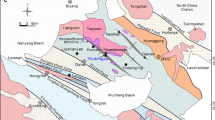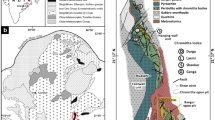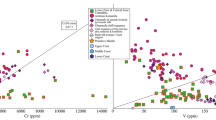Abstract
The chemical composition of mineral components of the Omolon pallasite was determined by neutron-activation. Six types of olivines were distinguished. Four types differ in the abundance of Co relative to Ni of CI chondrites. The fifth and sixth types were distinguished on the basis of REE distribution in them. Both last types are variably enriched in LREE relative to CI chondrites. In terms of Ca content relative to CI chondrite, these six types are subdivided into two groups: low-calcium and high-calcium. The difference in Ca contents can be caused by different cooling rate of the precursor of these olivines. The distribution pattern of siderophile elements in the pallasite metal indicates that a metallic phase experienced chemical transformations since the time of its formation. The analysis of chemical composition of accessory minerals showed that: (1) HREE are accumulated in tridymite; (2) troilite and daubreelite were formed under different temperature conditions; (3) magnetite is the mineral of the outer zone of melting crust. Four fragments with anomalous contents of lithophile elements were found in the pallasites and studied. The unusual chemical composition of phases and high degree of HREE fractionation in the fragments suggest their formation at high temperatures at the early stage of the Solar system evolution. It is assumed that the Omolon pallasite was formed as impact-brecciated mixture of the asteroid core (with composition close to IIIAB group of iron meteorites) and mantle olivine from incompletely differentiated parent body of chondrite composition.
Similar content being viewed by others
References
A. P. Vinogradov, “Meteorirtic Matter,” Geokhimiya, No. 11, 1275-1312 (1965).
J. T. Wasson and B. G. Choi, “Main-Group Pallasites: Chemical Composition, Relationship to III AB Irons, and Origin,” Geochim. Cosmochim. Acta 67, 3079–3096 (2003).
R. N. Clayton and T. K. Mayeda, “Oxygen-Isotope Studies of Achondrites,” Geochim. Cosmochim. Acta 60, 1999–2017 (1996).
D. W. Mittlefehldt, “The Composition of Mesosiderite Olivine Clasts and Implications for the Origin of Pallasites,” Earth Planet. Sci. Lett. 51(1), 29–40 (1980).
D. J. Malvin, J. T. Wasson, R. N. Clayton, and T. K. Mayeda, “Bocainva—a Silicate Inclusion Bearing Iron Meteorite Related To the Eagle Station Pallasites,” Meteoritics 20(2), 259–273 (1985).
G. Kurat, “Primitive Meteorites: An Attempt toward Unification,” Philos. Trans. R. Soc. London A325, 459–482 (1988).
A. M. Davis and E. J. Olsen, “Phosphates in the Pallasite Meteorites As Probes of Mantle Processes in Small Planetary Bodies,” Nature 353, 637–640 (1991).
W. Wahl, “The Pallasite Problem,” Geochim. Cosmochim. Acta 29(3), 177–181 (1965).
H. C. Urey, “Diamonds, Meteorites, and the Origin the Solar System,” Astrophys. J. 124, 623–637 (1956).
E. R. D. Scott, “Geochemical Relationships Between Some Pallasites and Iron Meteorites,” Mineral. Mag. 41 (318), 265–272 (1977).
R. T. Dodd, Meteorites: A Petrologic-Chemical Synthesis (Cambridge Univ. Press, Cambridge, 1981).
P. R. Buseck, “Pallasite Meteorites—Mineralogy, Petrology and Geochemistry,” Geochim. Cosmochim. Acta 41(6), 711–740 (1977).
E. R. D. Scott, “Pallasites—Metal Composition, Classification and Relationships with Iron Meteorites,” Geochim. Cosmochim. Acta 41(3), 349 (1977).
D. W. Mittlefehldt, T. J. Mc Coy, C. A. Goodrich, and A. Kracher, Non-Chondritic Meteorites from Asteroidal Bodies, in Planetary Materials, Ed. by J. J. Papike, (Mineral. Soc. Am., Washington, 1998).
E. Asphaug, C. B. Agnor, and Q. Williams, “Hut and — Run Planetary Collisions,” Nature 438, 155–160 (2006).
T. Tomiyama, G. R. Huss, K. Nagashima, and A. N. Krot, “Ion Microprobe Analysis of 53Mn-53Cr Systematics in Pallasite Meteorite,” Proc. 38th Lunar Planet. Sci. Conf. 38, 2007.
J. V. Bondar, I. I. Kashkarov, and V. P. Perelygin, “Tracks and Dislocations in Silicate Minerals of the Omolon Pallasite,” Proc. 33th Lunar Planet. Sci. Conf. 33, #1067 (2002).
A. A. Plyashkevich, H. E. Savva, and G. F. Pavlov, “Omolon—the First Pallasite of Northeast USSR,” Dokl. Akad. Nauk SSSR 318(1), 197–202 (1991).
A. Desrousseaux, J. C. Doukhan, H. Leroux, and J.C. Van Duysen, “An Analytical Electron Microscope Investigation of Some Pallasites,” Phys. Earth Planet. Inter. 103, 101–115 (1997).
J. V. Bondar, V. P. Perelygin, and R. I. Petrova, “Fossil Track Studies of the Omolon Pallasite Crystals,” Radiation Meas. 28, 337–340 (1997).
Yu. A. Shukolyukov, Yu. V. Klimenko, Yu. A. Kolyasnikov, and M. V. Koloskov, “Noble Gases in the Olivine from the Omolon Pallasite,” Geokhimiya, No. 7, 923–938 (1992).
V. A. Bronshten, V. E. Zharov, and R. L. Khotinok, “Atmospheric Trajectory and Orbit of the Omolon Meteorite,” Meteorit. Planet. Sci. 34, A131–A135 (1999).
G. M. Kolesov, N. A. Shubina, and A. Yu. Lyul, “Optimizing Instrumental Neutron Activation Analysis of Extraterrestrial Materials: Fragments of Lunar Rocks, Meteorites, Chondrules, and Ultrarefractory Inclusions,” J. Anal. Chem. 56, 1022–1028 (2001).
N. A. Shubina and G. M. Kolesov, “Decreasing the Detection Limits for the Neutron Activation Analysis of Trace Elements in Artificial and Natural Materials by Subtracting the Radionuclide Spectra of Matrix Elements from the Total Sample Spectrum,” J. Anal. Chem. 58, 875–881 (2003).
E. Anders and N. Grevesse, “Abundances of the Elements: Meteoritic and Solar,” Geochim. Cosmochim. Acta 53(1), 197–214 (1989).
V. V. Sharygin, S. V. Kovyazin, and N. M. Podgornykh, “Mineralogy of Olivine Hosted Inclusions from the Omolon Pallasite,” Proc. Lunar Planet. Sci. Conf. 37, #1235 (2006).
I. L. Gooding and R. Keil, “Relative Abundances of Chondrule Primary Textural Types in Ordinary Chondrites and Their Bearing on Conditions of Chondrule Formation,” Meteoritics 16(1), 17–43 (1981).
A. W. R. Bevan and H. J. Axon, “Metallography and Thermal History of the Tieschitz Unequilibrated Meteorite-Metallic Chondrules and the Origin of Polycrystalline Taenite,” Earth Planet. Sci. Lett. 47(353–360), 1980.
H. Nagahara, “Ni-Fe Metals in the Type 3 Ordinary Chondrites,” Nem. Nat. Inst. Polar. Res. Sp. Iss. 25, 86–96 (1982).
G. J. Gonsolmango and M. Drake, “Composition and Evolution of the Eucrite Parent Body: Evidence from Rare Earth Elements,” Geochim. Cosmochim. Acta 41(9), 1271–1282 (1977).
D. B. Curtis, and R. A. Schmitt, “The Petrogenesis of L-6 Chondrites: Insights from the Chemistry of Minerals,” Geochim. Cosmochim. Acta 43(7), 1001–1103 (1979).
A. K. Lavrukhina, A. Yu. Lyul, G. M. Kolesov, and G. V. Baryshnikova, “Features of Element Composition of Chondrules of the Okhansk H4 and Saratov L3–4 Ordinary Chondrites and Kainsaz CO3 Carbonaceous Chondrite,” Geokhimiya, no. 1, 44–63 (1987).
A. K. Lavrukhina, “Distribution of Na, K, and Rare-Earth Elements in Chondrules,” Geokhimiya, No. 9, 1231-1245 (1989).
J. V. Smith, “X-Ray Emission Microanalysis of Rock-Forming Minerals. II. Olivines,” J. Geol. 74(1), 1–16 (1966).
R. T. Dodd, “Minor Element Abundances in Olivines of the Sharps (H-3) Chondrite,” Contrib. Mineral. Petrol. 42(2), 159–167 (1973).
R. D. Warner and W. C. Luth, “Two Phase Data for the Join Monticellite (CaMgSiO4)-Forsterite (Mg2SiO4): Experimental Result and Numerical Analysis,” Am. Mineral. 58(11–12), 998 (1973).
Y. C. Stormer, “Calcium Zoning and Relationship to Silica Activity and Pressure,” Geochim. Cosmochim. Acta 37(8), 1815–1821 (1973).
P. R. Buseck and J. I. Goldstein, “Olivine Compositions and Cooling Rates of Pallasitic Meteorites,” Geol. Soc. Am. Bull. 80, 2141–2158 (1969).
J. V. Smith, “Minor Elements in Apollo 11 and 12 Olivine and Plagioclase,” Proc. 2nd Lunar Sci. Conf. Geochim. Cosmochim. Acta, No. 2 (Suppl.), 141 (1971).
N. V. Sobolev, Deep-Seated Inclusions in Kimberlites and the Problem of Composition of Upper Mantle (Nauka, Novosibirsk, 1974) [in Russian].
R. T. Dodd, “Calcium in Chondrite Olivine,” Geol. Soc. Am., Mem. 132, 651–560 (1972).
E. R. D. Scott, “Chemical Fractionation in Iron Meteorites and Its Interpretation,” Geochim. Cosmochim. Acta 36(11), 1205–1236 (1972).
E. R. D. Scott and J. T. Wasson, “Classification and Properties of Iron Meteorites,” Rev. Geophys. And Space Phys 13(4), 527–546 (1975).
E. R. D. Scott, “Iron Meteorites with Low Ga and Ge Concentrations—Compositions, Structure and Genetic Relationship,” Geochim. Cosmochim. Acta 42(8), 1243–1251 (1978).
E. R. D. Scott, “Pallasites—Metal Composition, Classification and Relationships with Iron Meteorites,” Geochim. Cosmochim. Acta 41(3), 349–360 (1977).
A. K. Lavrukhina, A. Yu. Lyul, and G. V. Baryshnikova, “On Distribution of Siderophile Elements in Fe, Ni-Phase of Ordinary and Enstatite Chondrites,” Geokhimiya, No. 5, 645–663 (1982).
I. Grossman, R. Ganapathi, and A. M. Davis, “Trace Elements in the Allende Meteorite-III. Coarse-Grained, Ca-Rich Inclusions Revisited,” Geochim. Cosmochim. Acta 41(11), 1647–1664 (1977).
A. Yu. Lyul, G. M. Kolesov, and A. K. Lavrukhina, “Distribution of Refractory Elements in the Fragments of the Kainsaz CO Carbonaceous Chondrite” Geokhimiya, No. 10, 1467–1475 (1990).
S. R. Taylor, “Chemical Characteristics of Ca-Al Inclusions in the Allende Meteorite,” Proc. Lunar Planet. Sci. 8, 1158–1160 (1978).
H. Palme, F. Wlotzka, K. Nagel, and A. El Goresy, “An Ultrarefractory Inclusion from the Ornans Carbonaceous Chondrite,” Earth Planet. Sci. Lett. 61(1), 1–12 (1982).
A. M. Davis and R. W. Hinton, “Trace Element Abundances in OSCUR, a Scandium-Rich Refractory Inclusion from the Ornans Meteorite,” Meteoritics 20(4), 633–634 (1985).
A. F. Noonan, J. Nelen, and F. Fredriksson, “Zr-Y Oxides and High-Alkali Glass in Ameboid Inclusion from Ornans,” Meteoritics 12(3), 332–335 (1977).
V. Ekambaram, I. Kawabe, T. Tanaka, et al., “Chemical Composition in the Murchison C2 Chondrite,” Geochim. Cosmochim. Acta 48(10), 2089–2105 (1984).
V. Ekambaram, S. Sluk, L. Grossman, and A. M. Davis, “Trace Elements in High-Temperature Inclusions from Murchison,” Meteoritics 19(4), 222–223 (1984).
A. M. Davis, T. Tanaka, L. Grossman, et al., “Chemical Composition of HAL, An Isotopically-Inusual Allende Inclusion,” Geochim. Cosmochim. Acta 46(9), 1627–1651 (1982).
P. R. Buseck and E. Holdsworth, “Phosphate Minerals in Pallasite Meteorites,” Mineral. Mag. 41(317), 9–102 (1977).
A. M. Davis and E. J. Olsen, “Phosphates in the Pallasite Meteorites As Probes of Mantle Processes in Small Planetary Bodies,” Nature 353, 637–640 (1991).
A. M. Davis and E. J. Olsen, “REE Patterns in Pallasite Phosphates—A Window on Mantle Differentiation in Parent Body,” Meteorit. Planet. Sci 31 (1996).
Author information
Authors and Affiliations
Corresponding author
Additional information
Original Russian Text © Z.A. Lavrentjeva, A.Yu. Lyul, G.M. Kolesov, 2012, published in Geokhimiya, 2012, Vol. 50, No. 1, pp. 38–47.
Rights and permissions
About this article
Cite this article
Lavrentjeva, Z.A., Lyul, A.Y. & Kolesov, G.M. The Omolon pallasite: Chemical composition, mineralogy, and genetic implications. Geochem. Int. 50, 34–43 (2012). https://doi.org/10.1134/S0016702912010065
Received:
Accepted:
Published:
Issue Date:
DOI: https://doi.org/10.1134/S0016702912010065




